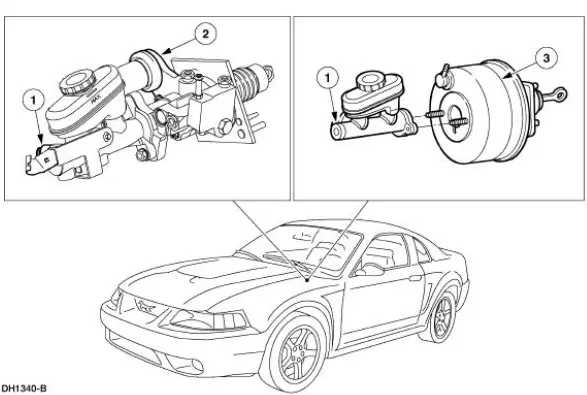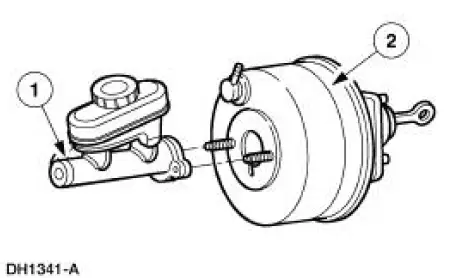Ford Mustang (1999-2004) Service Manual: Brake Booster - Vacuum (Description and Operation)
Power Brake Booster


The vacuum type power brake booster (2005):
- is a dual diaphragm, vacuum assisted power brake booster
- reduces brake pedal force and travel distance.
- is located on the LH side of the bulkhead in the engine compartment, between the brake pedal (2455) and the brake master cylinder (2140).
- is divided into separate chambers by the diaphragms.
- will not operate if vacuum is restricted or if any of the vacuum related power brake components fail.
- is installed as an assembly.
If the power assist fails, the brake system will continue to operate with increased brake pedal effort.
Hose and Check Valve
The power brake booster check valve (2365):
- is located on the front of the power brake booster.
- is installed separately; (install a new grommet when installing a new check valve).
- is positioned between the power brake booster and the power brake booster hose.
- closes when the engine is turned off.
- in the closed position, traps engine vacuum in the power brake booster
- retains vacuum to provide several power assisted brake applications with the engine off.


 Power Brake Actuation
Power Brake Actuation
Torque Specifications
...
 Brake Booster - Hydro-Boost (Description and Operation)
Brake Booster - Hydro-Boost (Description and Operation)
The Hydro-Boost brake booster is a hydraulically operated brake booster
powered by the power
steering pump (3A674). The power steering pump provides the fluid pressure to
operate both the
power brak ...
Other materials:
Throttle Position (TP) Sensor
Removal
NOTE: The 3.8L engine is shown; the 4.6L (2V) is similar.
1. Disconnect the battery ground cable. For additional information,
refer to Section.
2. Remove the throttle position (TP) sensor.
Disconnect the connector.
Remove the screws, ...
Installation
1. Install the RH engine insulator.
Install the nuts.
Install the bolts.
2. Install the LH engine insulator.
3. Connect the engine ground strap.
4. Install the bracket.
5. Lower the vehicle.
6. Lower the engine.
7. Raise the vehicle.
8. Ins ...
Safety precautions
WARNING: Do not overfill the fuel tank. The pressure in an
overfilled tank may cause leakage and lead to fuel spray and fire.
WARNING: The fuel system may be under pressure. If you hear
a hissing sound near the fuel filler inlet, do not refuel until the
sound ...
